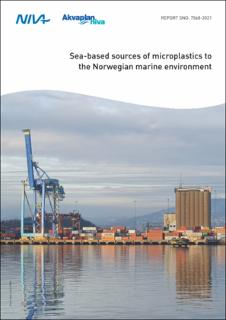| dc.contributor.author | Lusher, Amy | |
| dc.contributor.author | Pettersen, Ragnhild | |
| dc.date.accessioned | 2021-05-04T13:07:44Z | |
| dc.date.available | 2021-05-04T13:07:44Z | |
| dc.date.created | 2021-05-03T15:31:20Z | |
| dc.date.issued | 2021 | |
| dc.identifier.isbn | 978-82-577-7303-8 | |
| dc.identifier.issn | 1894-7948 | |
| dc.identifier.uri | https://hdl.handle.net/11250/2753530 | |
| dc.description | Project Manager Amy Lusher | en_US |
| dc.description.abstract | This report is an update of data available on primary and secondary discharges of microplastics from sea-based sources to the Norwegian marine environment. Nine broad potential sea-based source categories are relevant to the Norwegian marine environment. These include maritime coatings, maritime traffic, ports marinas and shipyards, decommissioning activities, land-based industry (with discharged into the marine environment), fisheries, aquaculture, petroleum-related activities, and other offshore activities. Sources of primary microplastics can be linked production sites for plastics and paints which have discharges to the sea, or maintenance facilities in coastal areas. Petroleum activities also have discharges of primary microplastics to the ocean. Secondary microplastics can be derived from maintenance, decommissioning and wear and tear across various maritime sectors as well as the breakdown of large plastic items lost or discarded at sea. There is surprisingly little information on the quantities of microplastics released into ocean from coastal or other sea-based sources. Few of the source categories have some information available, and the certainty around the data for all source categories was classed as medium or low. This makes validating emissions values and interpreting the data challenging. As there is little certainty behind the available data, no sea-base source was identified as the biggest contributor. Future research must focus on obtaining comparable empirical data across all potential source categories. This includes calculations of emissions based on actual reported discharge values and comparative environmental investigations. The relative size of the sector may play a role and this should be investigated further. | en_US |
| dc.language.iso | eng | en_US |
| dc.publisher | Norsk institutt for vannforskning | en_US |
| dc.relation.ispartof | NIVA-rapport | |
| dc.relation.ispartofseries | NIVA-rapport;7568 | |
| dc.relation.ispartofseries | Miljødirektoratet-rapport;M-1911 | |
| dc.subject | Marin eller kystvann | en_US |
| dc.subject | Marine or costal water | en_US |
| dc.subject | Miljøgifter | en_US |
| dc.subject | Environmental pollution | en_US |
| dc.subject | Plastforurensning | en_US |
| dc.subject | Plastic pollution | en_US |
| dc.title | Sea-based sources of microplastics to the Norwegian marine environment | en_US |
| dc.type | Research report | en_US |
| dc.description.version | publishedVersion | en_US |
| dc.rights.holder | his report is an update of data available on primary and secondary discharges of microplastics from sea-based sources to the Norwegian marine environment. Nine broad potential sea-based source categories are relevant to the Norwegian marine environment. These include maritime
coatings, maritime traffic, ports marinas and shipyards, decommissioning activities, land-based industry (with discharged into the marine environment), fisheries, aquaculture, petroleum-related activities, and other offshore activities. Sources of primary microplastics can be linked
production sites for plastics and paints which have discharges to the sea, or maintenance facilities in coastal areas. Petroleum activities also have discharges of primary microplastics to the ocean. Secondary microplastics can be derived from maintenance, decommissioning and wear and tear
across various maritime sectors as well as the breakdown of large plastic items lost or discarded at sea. There is surprisingly little information on the quantities of microplastics released into ocean from coastal or other sea-based sources. Few of the source categories have some information
available, and the certainty around the data for all source categories was classed as medium or low. This makes validating emissions values and interpreting the data challenging. As there is little certainty behind the available data, no sea-base source was identified as the biggest contributor.
Future research must focus on obtaining comparable empirical data across all potential source categories. This includes calculations of emissions based on actual reported discharge values and comparative environmental investigations. The relative size of the sector may play a role and this should be investigated further. | en_US |
| dc.subject.nsi | VDP::Matematikk og naturvitenskap: 400 | en_US |
| dc.subject.nsi | VDP::Mathematics and natural scienses: 400 | en_US |
| dc.source.pagenumber | 104 | en_US |
| dc.source.issue | 7568 | en_US |
| dc.identifier.cristin | 1907839 | |
| cristin.ispublished | true | |
| cristin.fulltext | original | |
